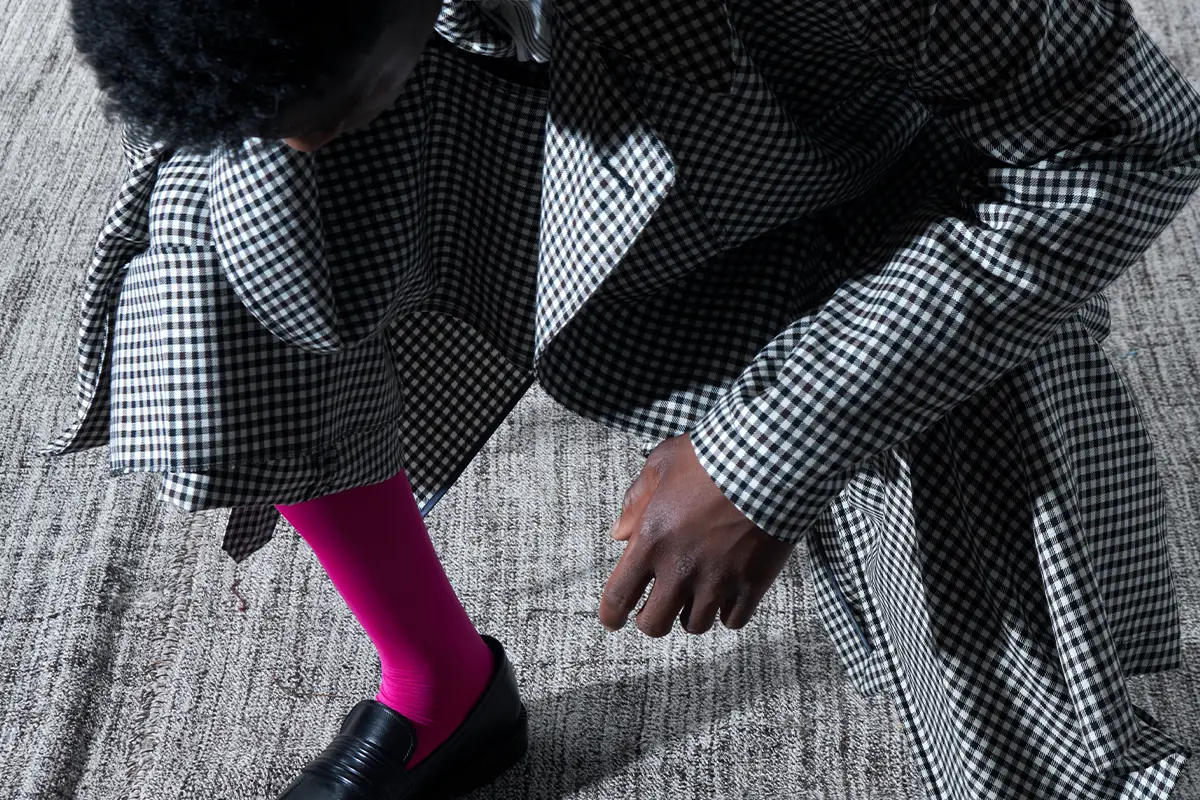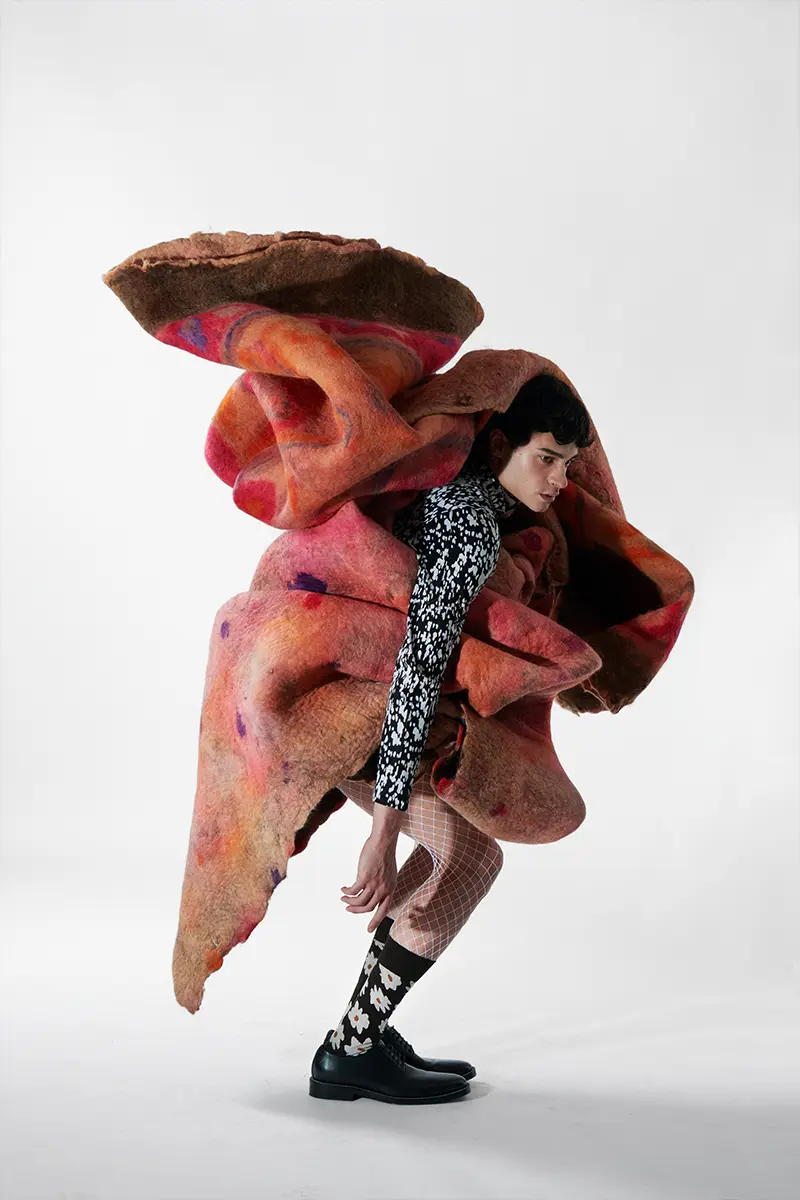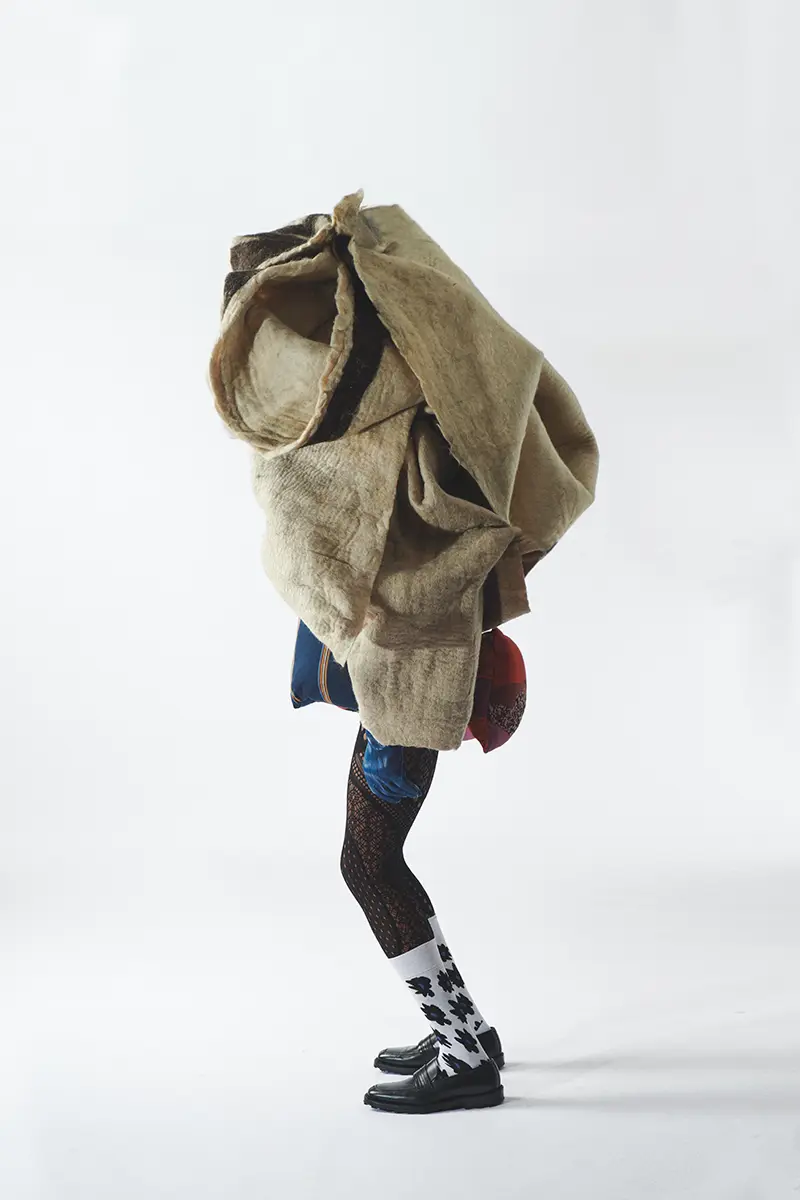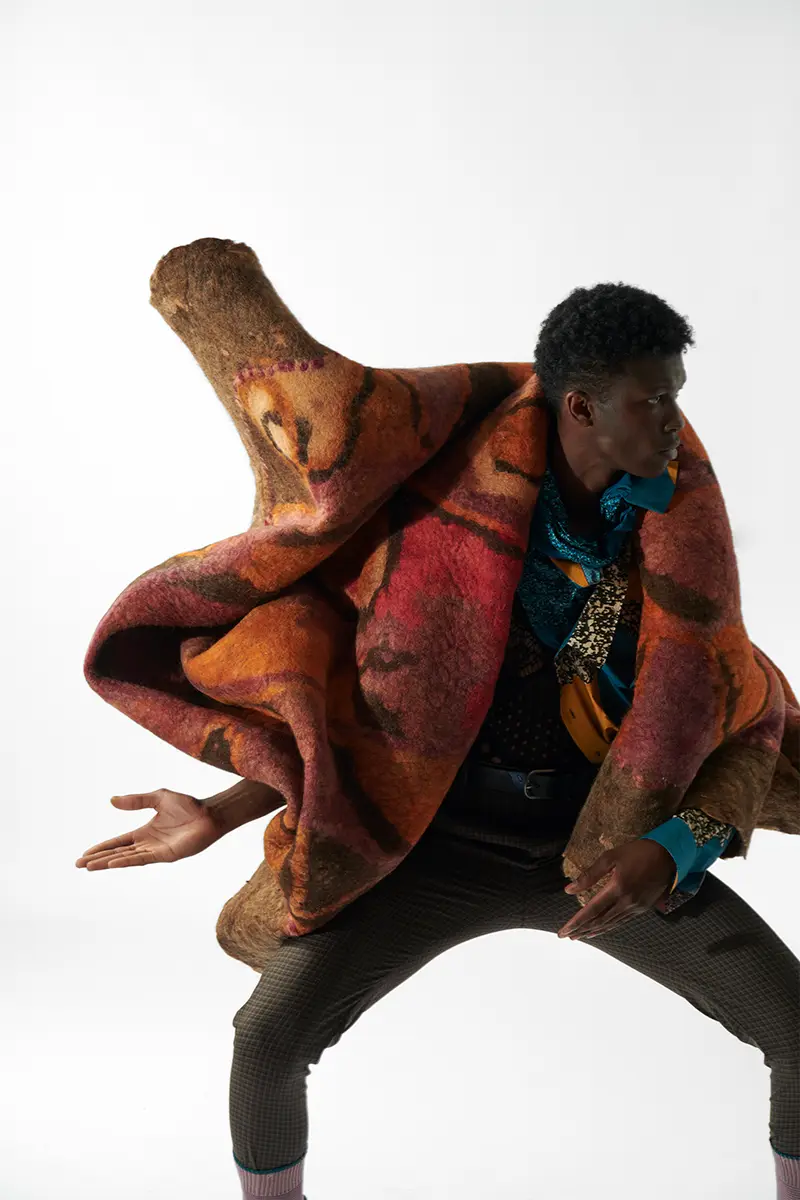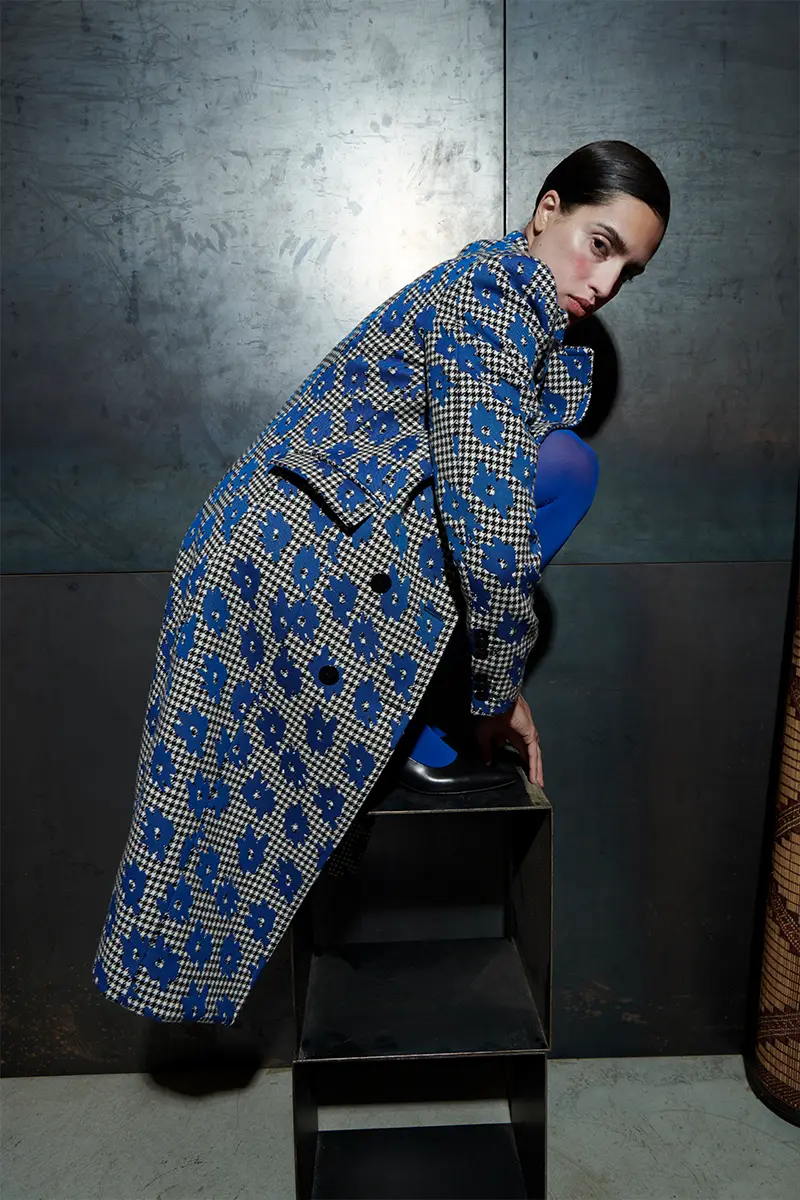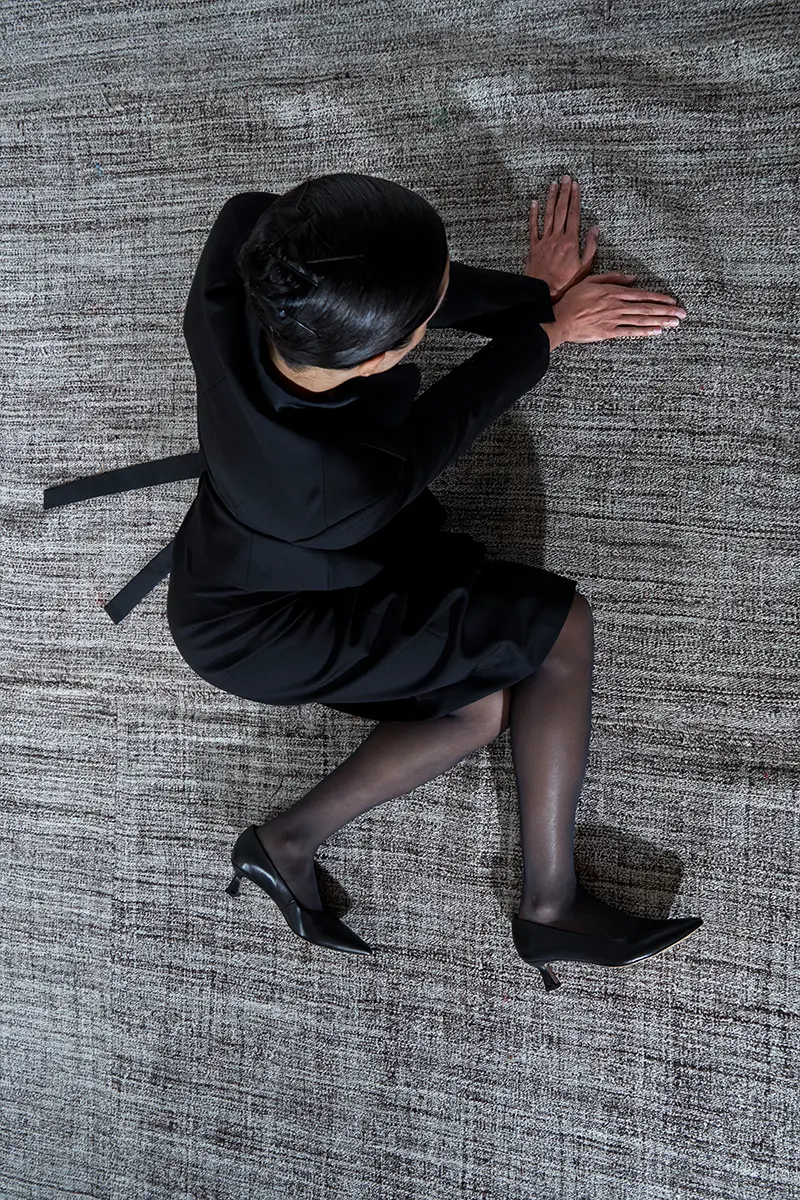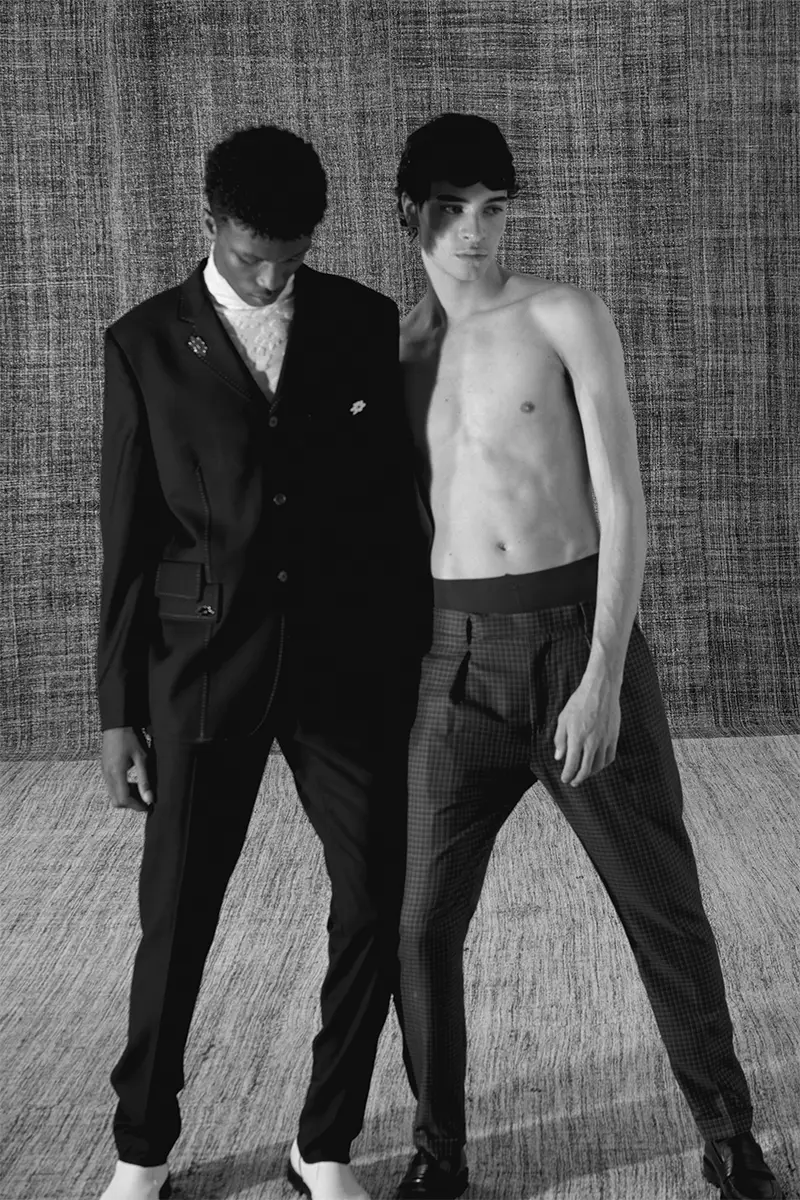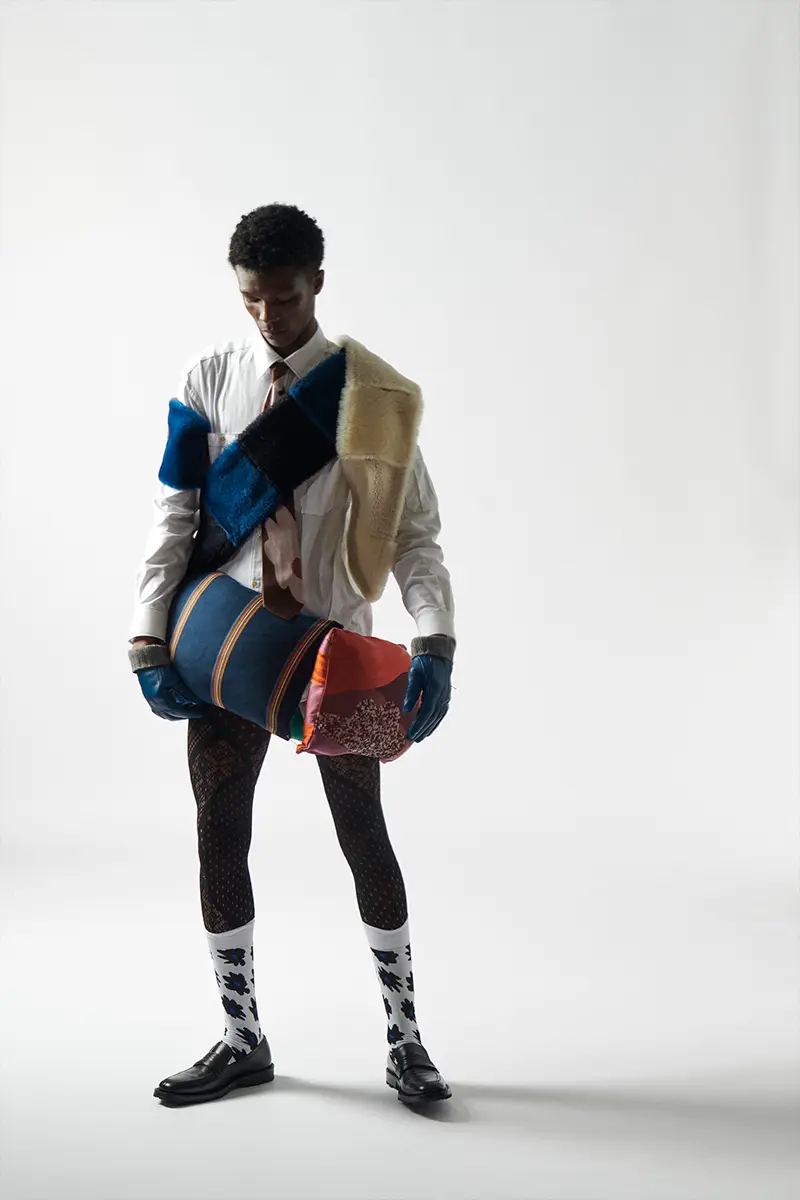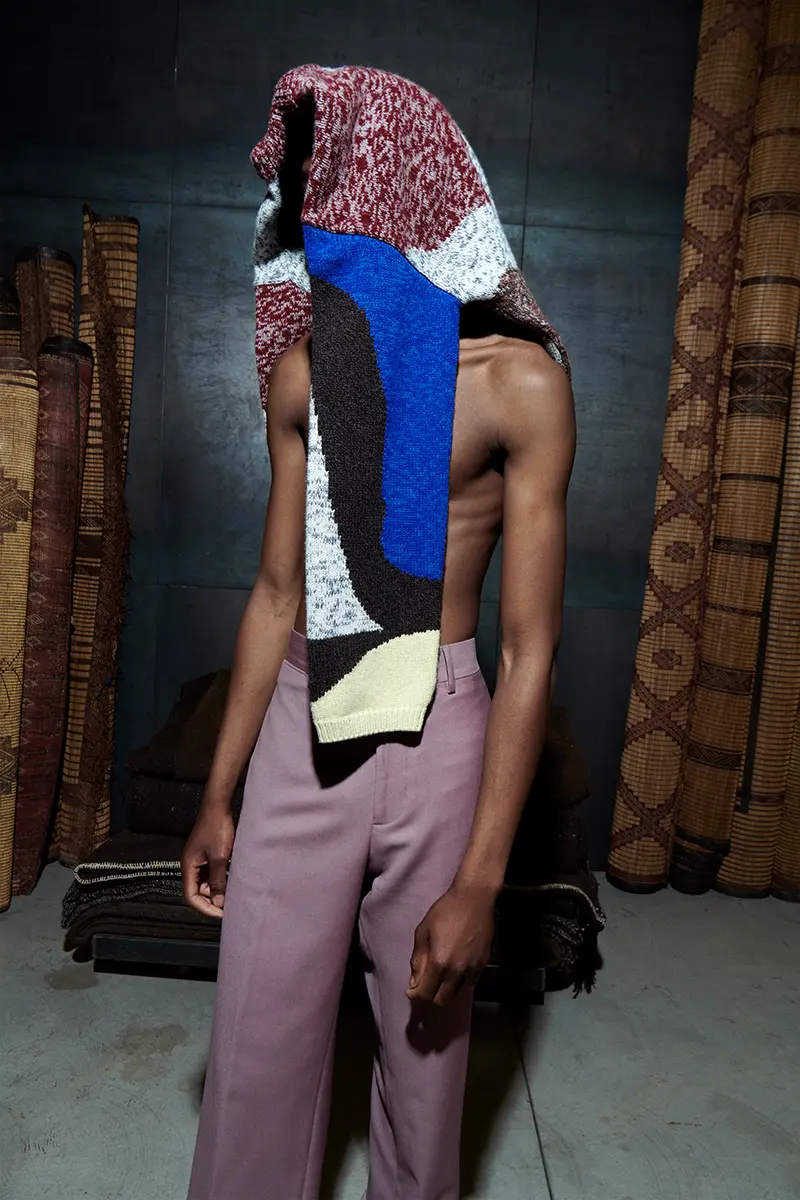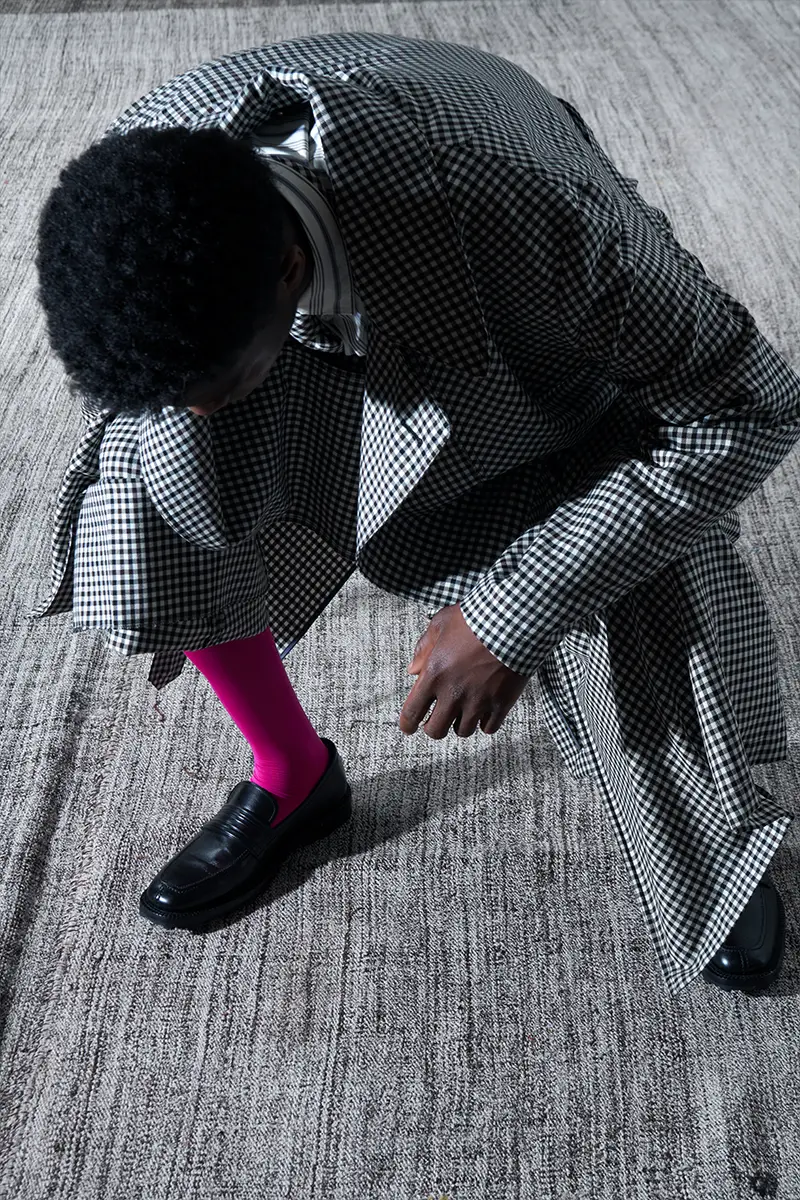When Sir Paul Smith discovered «a shop of handmade rugs» in Milan, he brought their essence to his London showroom and to the upcoming Fall Winter collection
An exchange between the worlds of art and fashion through handmade rugs from the Sahara Desert. Altai Gallery collaboration Paul Smith
British designer Sir Paul Smith defines his collaboration with founders of Milan-based Altai Gallery, Raffaele and Elisa Carrieri, as a marriage of minds. Raffaele shares that it is their individual non-conformist natures that brought them together.
The trio was initially united in their common mission to bring traditional and nomadic know-how of ancient craftspeople to the forefront. Altai Gallery boasts of the world’s only – and last collections of primitive nomadic rugs, hailing from Kurdistan, the Sahara etc. Three generations of the Carrieri family connoisseurs have curated Altai’s exclusive collection.
With his commitment to craftsmanship, Sir Paul Smith’s paths crossed with Altai’s founders. In March 2023, eleven of Altai’s antique silk rugs were exhibited in the Paul Smith flagship store in Mayfair. As the British designer says, «You can find inspiration in everything»; the Altai handmade rugs further feature as a strong influence in the upcoming AW23 collection across shirting and knitwear.
The trio in conversation with Lampoon discusses all things art, the business of craftsmanship, opposition of homogenity and the difference between homofabers and homosapiens.
The coming together of like-minded non-conformists. Collaboration between Altai Gallery and Paul Smith
AARUSHI SAXENA
How did the collaboration between Altai Gallery and Paul Smith come about?
SIR PAUL SMITH
I’d been working in Milan with the furniture company, De Padova. Through that collaboration I discovered the world of Altai when I was invited to visit their gallery. I went and was reeled in by the collection of rugs. The whole aesthetic was really similar to what I’ve always believed in – handmade, craftsmanship and the world of nomads.
When I met Raffaele and Elisa at the gallery, I suggested the collaboration. I have several shops in London, but one of them is particularly attached to the world of creativity outside of clothes – with furniture, ceramics etc.
ELISA CARRIERI
Paul Smith’s store is like an art gallery in some way. We all fell in harmony within ten minutes and decided to do something together. Our handmade rugs are really powerful and full of soul. From the first look they immediately create a pull. Paul felt it. The collaboration happened very quickly and easily.
RAFFAELE CARRIERI
The connection between us is also because Paul and Altai are both doing something non-conformist just by trying to break the walls between the worlds of art, craftsmanship and fashion. In wanting to remove these ‘old style’ borders – we found something that united us.
Altai gallery – handmade rugs. Every piece has its own little message or secret, it is about roughness
SIR PAUL SMITH
The problem today is that the world is so homogenized. Before, everywhere you’d go would be different – London, Paris, Capri, New York. You could discover a new panini shop or a flower boutique, an exclusive shop for socks. But now every street looks the same, it’s so boring.
When I find something like Altai, a shop of handmade rugs, where nothing can be mass produced in any way – it’s exciting. Every piece has its own little message or secret, it is about roughness.
RAFFAELE CARRIERI
Yes, the world is like a row of airport shops now. Our rugs’ appearance is due to the result of necessities; necessities of the nomadic people.
Traditions that may have started four or five thousand years ago are still alive and being made exactly the same way as they were then. Because the nomadic lifestyle has been the same for many years. For us, it is stimulating to see this today. Paul has the same kind of approach in the way he views art.
Paul Smith’s AW23 collection: inspired by ‘modernism, interior design and architecture’. The rough collaboration with Altai Gallery
SIR PAUL SMITH
Can you imagine how it feels for a clothes designer to see these rugs and know their story? This is exactly what we aspire to all the time.
My collection is about ‘modernism, interior design and architecture.’ So the rugs’ influence is part of the interior design section, while modernism is about using technique and fabrics but mixed with the traditional ways of making. Combining the heritage of craftsmanship and handmade with modernism was the real purpose, for example, the juxtaposition of a beautiful pair of linen trousers or tailored suit but with a print or knit patch made by hand.
AARUSHI SAXENA
There’s talk of a ‘rug print’ in your AW23 collection, is there a specific piece from Altai that might’ve informed it?
SIR PAUL SMITH
The print or knitwear that I did in this collection is influenced by the way the yarn was used. Nomadic people only had small batches of yarn, so they changed it from time to time within one piece, forming different rough textures. For me the inspiration is in the mix of colors, patterns and texture that you would find in a rug. But also, the world, the attitude, the conversation that transpired at Altai. It was a cocktail of everything that happened when I visited the gallery and talked to these guys; talking to people who have the same aesthetic as you.
It’s a rug story: of color and stripes inspired by Paul Smtih. Altai Gallery’s rough rugs
AARUSHI SAXENA
There were eleven rugs curated for the collaborative exhibition in the Paul Smith London flagship store. Can you share the criteria defined for their selection?
SIR PAUL SMITH
I have collected lots of pictures from when I was visiting the Altai Gallery. There were some felted rough rugs; some monochromatics made from different parts of the same wool which appeared red overall, but you could see different shades of red, sometimes pale, sometimes vibrant. One rug even looked like my hair. When we were discussing the eleven rugs, one of the things I learnt was to be focused – so we narrowed it down to two types for my store.
ELISA CARRIERI
The first thing I thought was that Paul is synonymous with stripes. We have this huge collection of Kurdish heritage, we framed them for him. We didn’t want to diversify too much, so we gave the audience a selective typology. The first one was long pile rugs and the second type was stripes, for Paul’s signature.
A marriage of minds: coloring the monochromatic cultural landscape of today
RAFFAELE CARRIERI
For the nomadic and primitive population, the hues of the colors they used were not only because of the need for beauty, but also for protection. These people from Central Asia and the Sahara were surrounded by vastly monochromatic landscapes. In some way Paul is doing the same thing about the western monochromatic cultural landscape that we live in now.
SIR PAUL SMITH
Thank You. The thing to consider here is that Paul Smith the company, is still an independent company. It is a miracle for me, with all the big brands around today and it’s tough because all of them have so much power in terms of marketing and fashion shows and number of shops.
The good thing about being independent is you’re not always financially motivated with the greed of the shareholders. It’s very much about heart and spontaneity. That’s what is so rare in today’s world.
Then there’s also what I found from the visit to Altai Gallery and seeing the rugs. It was parallel to the way I think – it was a marriage.
The Picasso connection – African art in Paris, modern art and rough primitive art
RAFFAELE CARRIERI
When I was young, I played on the knees of Picasso, because he was my grandfather’s best friend. Together, they started to collect African art in Paris. This is the beginning of Altai in some way. I was always surrounded by modern art and rough primitive art.
SIR PAUL SMITH
Picasso was a huge fan of Iberian art, African masks and oceanic influence. He was also completely open about being influenced by other artists and was not embarrassed to say it out loud.
I also curated an entire exhibition of the Picasso Museum in Paris. The fact that I got asked to do that, blew me away. With all the knowledgeable artists, art historians and experts on Picasso out there, I was chosen and given carte blanche to do whatever I want. This means that there is a confidence in a lateral way of thinking. It takes a brave person to become lateral, because the most obvious thing is to go down the same route, follow what other people are doing and stay on trend.
Sir Paul Smith, Raffaele and Elisa Carrieri (Altai gallery). The business of craftsmanship
AARUSHI SAXENA
Speaking of staying on trend, the fashion industry is largely informed by trends, where does the ‘business of craftsmanship’ find place in that context?
SIR PAUL SMITH
My company works in India for the exact opposite reasons from everybody else. Mostly people choose India (for outsourcing) because of the low prices (cheap labor) but we make in India because these artisans can still do handmade buttonholes, embroidery and dyeing. However, it has become increasingly hard to find artisans who do it now. Sadly, the young people and generation want to enter the world of technology as it earns them a lot of money. They are not content with having a craft in hand.
RAFFAELE CARRIERI
The world is changing. Nomadic people have exclusivity in the way they make things and nothing is more exclusive than art. Nomadic and primitive lifestyles, such as those found in Altai’s world have the potential to be beneficial for humanity’s future. Nature should be carefully used and the relationship with our environment considered.
SIR PAUL SMITH
When I started my business with my then girlfriend and now wife, the problems about being a designer were different: You had an idea in your head and your heart – and you designed the clothes, hoping somebody liked what you did. Now it’s marketing, social media, networking and then the clothes. Today, people are nervous about individuality, they are insecure and they want to be uniform. They want to belong to a club, no matter what club.
The difference between homofabers and homosapiens: the rich, the blind and the dutiful of the art world
RAFFAELE CARRIERI
It is the same story in the art world. You are a good collector if you have pieces that are recognizable and allow you to be part of that exclusive club. Not many people want to be recognized as part of a new niche.
What we are seeing is interesting – the new collectors spend a lot of money for artwork they don’t like, nor do they feel. Purchases are made based on galleries’ suggestions for reasons of investment and symbols of status.
We also noticed that many art collectors are coming to Altai for different reasons. They want to feel the emotion behind art once again and experience something that brings joy from very far away worlds. It is humanity’s need for beauty. This is the difference between homofabers and homosapiens.
SIR PAUL SMITH
The world of art has become more of a financial business opportunity, making many of the big galleries in the world extraordinarily wealthy. For people with new money, it seems to be the best investment, while in the past this investment was in the form of property, stocks and shares. These new big collectors have a checklist of the artists they want to own, without really appreciating the art or the story behind the frame.
Preserving indigenous communities and primitive know-how. Altai and Sir Paul Smith sharing the same commitment
AARUSHI SAXENA
Appreciation of craftsmanship is slowly becoming a social trend, born from awareness about inclusivity and sustainability. It is finally being attributed to indigenous communities, and primitive know-how. How are exhibitive spaces responding to representation talks?
SIR PAUL SMITH
I have only one thing to say: wouldn’t it have been nice if they had done that all the time? Instead of making it part of what they should do now in the modern world? When people say, ‘oh we should be careful about global warming,’ I say, ‘well, we should always be careful about global warming.’ It is just another marketing tool like everything else.
Sir Paul Smith
Paul Smith is a British clothing brand owned and founded by Sir Paul Smith who was knighted by the Queen in 2000 for his services to the British fashion industry. He is renowned for his work with patterns, colors and his signature stripes. Sir Paul’s commitment to craftsmanship across different creative worlds from fashion to interior has led him to open unique clothing stores / galleries across 70 countries.
Altai Gallery and the handmade rugs
Milan-based Altai Gallery traces its routes across three generations of the Carrieri family who curated an exclusive selection of primitive nomadic handmade rugs. The duo Raffaele and Elisa Carrieri currently represent the gallery. In addition to their studio, Altai has collaborated with numerous fashion brands and luxury hotels across the globe.
A rough collaboration – photography Rita Lino, stylist Juan Camilo Rodriguez
The rough collaboration between Sir Paul Smith and Altai gallery founders has been chronicled by photographer Rita Lino and stylist Juan Camilo Rodriguez, whose shot the Paul Smith AW 24 collection in Altai gallery in Milan, Italy
Photography Rita Lino
Stylist Juan Camilo Rodriguez
Hair Daniela Magginetti @BlendManagement, makeup Manuel Montanari, set design Caterina Pomante
Casting @IKKICasting, photography assistant Federico Pompei, styling assistant Ester di Lorenzo
Talents Sanoussy @SuccessModels, Federico @ILoveModels, Athina @EliteModel
Thanks to Altai Gallery


